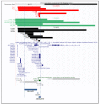8p23.2-pter Microdeletions: Seven New Cases Narrowing the Candidate Region and Review of the Literature
- PMID: 33925474
- PMCID: PMC8146486
- DOI: 10.3390/genes12050652
8p23.2-pter Microdeletions: Seven New Cases Narrowing the Candidate Region and Review of the Literature
Abstract
To date only five patients with 8p23.2-pter microdeletions manifesting a mild-to-moderate cognitive impairment and/or developmental delay, dysmorphisms and neurobehavioral issues were reported. The smallest microdeletion described by Wu in 2010 suggested a critical region (CR) of 2.1 Mb including several genes, out of which FBXO25, DLGAP2, CLN8, ARHGEF10 and MYOM2 are the main candidates. Here we present seven additional patients with 8p23.2-pter microdeletions, ranging from 71.79 kb to 4.55 Mb. The review of five previously reported and nine Decipher patients confirmed the association of the CR with a variable clinical phenotype characterized by intellectual disability/developmental delay, including language and speech delay and/or motor impairment, behavioral anomalies, autism spectrum disorder, dysmorphisms, microcephaly, fingers/toes anomalies and epilepsy. Genotype analysis allowed to narrow down the 8p23.3 candidate region which includes only DLGAP2, CLN8 and ARHGEF10 genes, accounting for the main signs of the broad clinical phenotype associated to 8p23.2-pter microdeletions. This region is more restricted compared to the previously proposed CR. Overall, our data favor the hypothesis that DLGAP2 is the actual strongest candidate for neurodevelopmental/behavioral phenotypes. Additional patients will be necessary to validate the pathogenic role of DLGAP2 and better define how the two contiguous genes, ARHGEF10 and CLN8, might contribute to the clinical phenotype.
Keywords: 8p23.2-pter microdeletion; 8p23.3; ARGHEF10; DLGAP2; behavior disorder; candidate region; chromosomal microarray analysis (CMA); critical microdeletion region (CR); developmental delay; small deletions.
Conflict of interest statement
The authors declare no conflict of interest.
Figures



References
Publication types
MeSH terms
LinkOut - more resources
Full Text Sources
Other Literature Sources
Miscellaneous

